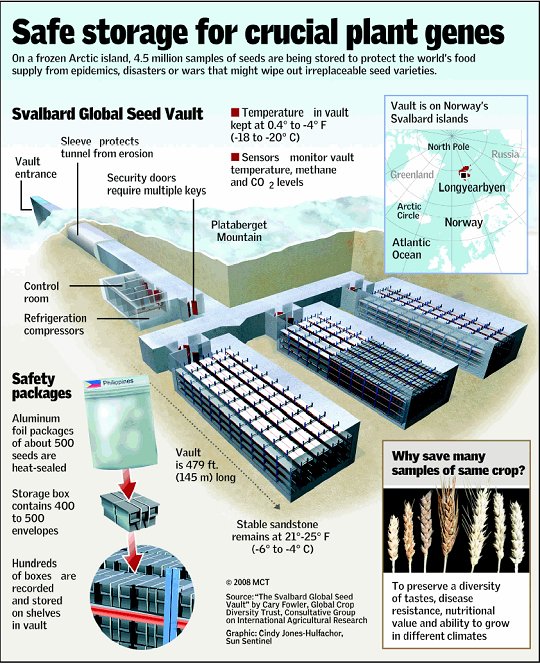Today in History, June 19: Svalbard Global Seed Vault
2006, on June 19, the prime ministers of Norway, Sweden, Finland, Denmark, and Iceland's laid "the first stone" to the Svalbard Global Seed Vault.

The Svalbard Global Seed Vault is a secure seed bank on the Norwegian island of Spitsbergen. About 1,300 km (810 mi) from the North Pole. The seed vault is an attempt to insure against the loss of seeds in other gene-banks during large-scale regional or global crises.The seed vault is managed under terms spelled out in a tripartite agreement between the Norwegian government, the Crop Trust and the Nordic Genetic Resource Center.
The Norwegian government entirely funded the vault's US$9 million construction. Storing seeds in the vault is free to end users, with Norway and the Crop Trust paying for operational costs. Primary funding for the Trust comes from various governments worldwide and organizations, such as the Bill & Melinda Gates Foundation.
The seedbank is 120 m (390 ft.) inside a sandstone mountain on Spitsbergen Island. It is outfitted with robust security systems. Seeds are packaged in special three-ply foil packets and heat sealed to exclude moisture. The facility is managed by the Nordic Genetic Resource Center, though there is no permanent staff on-site.
Spitsbergen is considered ideal because it lacks tectonic activity and has permafrost, which aids preservation. Being 130 m (430 ft.) above sea level will keep the site dry. Even if the ice caps melt. Locally mined coal provides power for the refrigeration units which further cool the seeds to the internationally recommended standard of -18 °C (-0.4 °F). If the equipment fails, several weeks will elapse before the facility rises to the surrounding sandstone bedrock's temperature of -3 °C (27 °F).
A feasibility study prior to construction determined that the vault could preserve most major food crops' seeds for hundreds of years. Some could survive far longer, possibly thousands of years. Among those are important grains.
The Svalbard Global Seed Vault officially opened on February 26, 2008. Approximately 1.5 million distinct seed of agricultural crops are thought to exist. The variety and the volume of seeds stored will depend on the number of countries participating in this project. The facility has a capacity to conserve 4.5 million seeds.
The adjacent Arctic World Archive provides a similar service for data. They are etched as code into reels of film. The films, when properly preserved, should last for 1,000 years.
Recent Comments
32
A fascinating article Eric! I've always been intrigued with Svalbard, and the Global Seed Project from its inception in 2006. It's also a place I always wanted to travel to.
Today I learned SO much more..fantastic post!
The most northern point I have ever been is the North Cape (71° 10′ 21″ N). That is about the same latitude as Prudhoe Bay in Alaska. The Spitsbergen are even more North (78° 45′ N). And it's pretty cold over there.
Ny Alesund is the northernmost town in the world (78 55') on Spitsbergen and I've always wanted to visit it.
However, surprisingly for its high latitude it isn't always as cold as it would appear, and certainly not as cold as parts in Canada with the same latitude due to the Gulf stream from the southern ocean.
You are right. Wouldn't we in Europe not have the Gulf stream it would be quite a bit colder. If I'm right. New York is on the same latitude as Naples and only slightly more north than Lisbon. But the weather in NY is most of the time, especially in winter, colder.
No doubt Eric, you are spot on. New York is at approx. latitude 40.7' North, in fact both Naples and Rome are slightly north of New York City, in latitude. Milan at 45 latitude is much further north than New York, and the weather is much milder.
And without a doubt, New York is has much colder average temps than both Cities in Italy. This can only be due to the Gulf Stream.
I was surprised that it's 130 m (430 ft.) above sea level only. I heard in case the ice of both earth capes would melt completely, the sea level would increase by approximately 200 m (660 ft.). But on their site they state that 130 m is enough to keep it dry from flooding. I hope they know what they. Otherwise I would be a disaster.
Maybe not so crazy. When our scientist will have mutated all plants, we might be glad to have some place to get the real stuff!
Thanks for the read, Mark.
See more comments


Us weak humans and our small minds really think we are making a difference, don't we?
This is an interesting history lesson, as always, Eric. Thank you
I think for once some governments did something reasonable. When you see how little it cost to build the Vault (US$9) and what the benefit of it can be, then I find it was worth building this Vault. Because when our scientist will have mutated all plants, we will be glad to have some place to get untreated and unchanged seeds.
Thanks Mickey for the read.